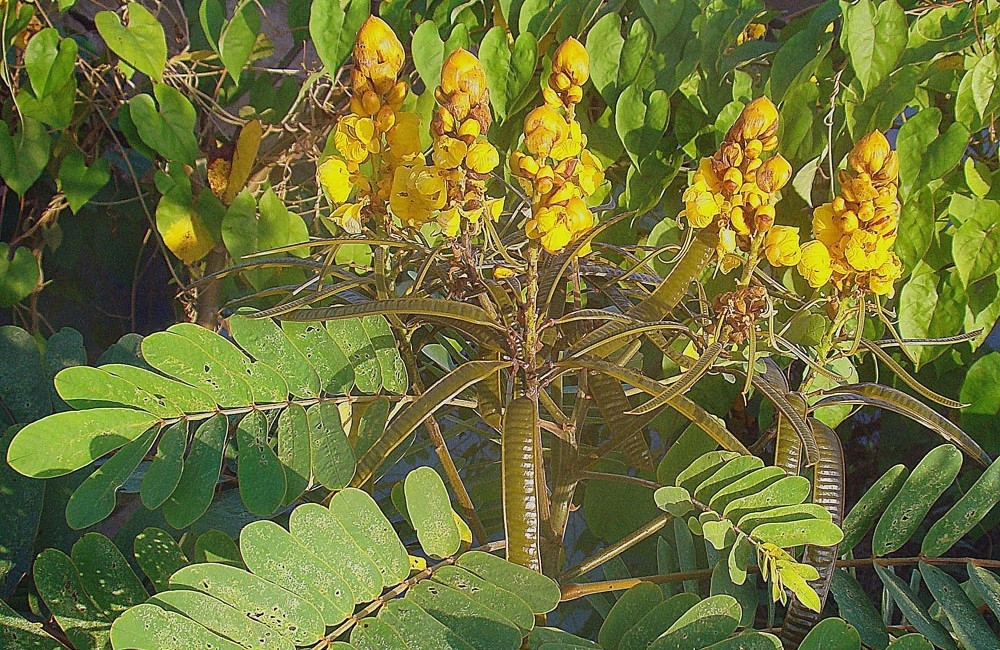

Two plants frequently found in the North of Brazil could become alternatives to sugarcane as raw materials for the production of second-generation ethanol and bioelectricity, according to studies by Brazilian researchers (Senna reticulata; photo: Dick Culbert/Wikimedia Commons)
Two plants frequently found in the North of Brazil could become alternatives to sugarcane as raw materials for the production of second-generation ethanol and bioelectricity, according to studies by Brazilian researchers.
Two plants frequently found in the North of Brazil could become alternatives to sugarcane as raw materials for the production of second-generation ethanol and bioelectricity, according to studies by Brazilian researchers.

Two plants frequently found in the North of Brazil could become alternatives to sugarcane as raw materials for the production of second-generation ethanol and bioelectricity, according to studies by Brazilian researchers (Senna reticulata; photo: Dick Culbert/Wikimedia Commons)
By Elton Alisson | Agência FAPESP – Duckweed and Senna reticulata, common name mata-pasto (“pasture killer”), plants frequently found in Brazil’s North region, have significant potential for use as raw material to produce bioenergy, according to studies by researchers affiliated with the National Institute of Science and Technology (INCT) for Bioethanol, one of the INCTs supported by FAPESP and the National Council for Scientific and Technological Development (CNPq) in the state of São Paulo.
Laboratory tests show that when biomass from duckweed is submitted to saccharification it produces large amounts of simple sugar than sugarcane, the main raw material currently used to produce second-generation ethanol. S. reticulata grows very fast and could be a viable option for bioelectricity production in the Amazon without causing deforestation, the researchers say in reports on their studies published in Bioenergy Research.
“S. reticulata and duckweed could be complementary or alternative to sugarcane for the production of bioenergy,” Marcos Silveira Buckeridge, head of INCT-Bioethanol and principal investigator for the projects, told Agência FAPESP.
The researchers analyzed the composition and biomass saccharification potential of both plants for bioenergy production. The results of their analysis of five species of duckweed (Spirodela polyrhiza, Landoltia punctata, Lemna gibba, Wolffiella caudata and Wolffia borealis) show that three monosaccharides – glucose, galactose and xylose – account for 51.4% of the cell wall in this plant.
They also show that duckweed biomass displays low resistance to hydrolysis or saccharification. In this process, lignocellulosic biomass is placed in contact with an enzymatic cocktail to convert the complex sugars present in cell walls into simple sugars that can be fermented by yeast to produce second-generation ethanol.
“Duckweed displays low resistance to hydrolysis, probably because it contains very little lignin,” Buckeridge said. Lignin is a macromolecule that enhances plant tissue rigidity, impermeability and resistance to biological and mechanical attack when it is associated with cell wall hemicellulose and cellulose.
The analysis of S. reticulata showed that almost 50% of the plant’s leaf and stem biomass consisted of pectin, hemicellulose and cellulose. Lignin varied considerably in the plant’s organs. The largest proportions were found in the roots (35%), leaves (10%) and stem (7%).
“When we analyzed the whole biomass of the plant, we found that the leaves contained a huge amount of starch – far more than we’ve ever detected in other plants,” Buckeridge said.
The researchers also evaluated the effect of rising levels of carbon dioxide (CO2) in the atmosphere on biomass composition in S. reticulata. They concluded that the increase in CO2 did not significantly alter the proportion of cell wall lignin, but reduced the proportion of lignin in leaves and roots. It also increased the amount of leaf starch by 31% and improved biomass saccharification by 47%.
“The plant develops very well at high temperatures, so it’s a worthwhile option for producing bioelectricity by burning its biomass, especially in the North of Brazil,” Buckeridge said.
Duckweed is found in all parts of the world. Besides being an option for the production of second-generation ethanol, it can also be used for water cleansing thanks to its lower resistance to hydrolysis than sugarcane. “Another advantage of duckweed compared with other plants that have been studied for bioenergy production is that it doesn’t take up any space on land and hence doesn’t compete with food crops,” Buckeridge said.
The article “Senna reticulata: a viable option for bioenergy production in the Amazonian region” (doi: 10.1007/s12155-020-10176-x) by Adriana Grandis, Bruna C. Arenque-Musa, Marina C. M. Martins, Thais Olivar Maciel, Rachael Simister, Leonardo D. Gómez and Marcos S. Buckeridge can be retrieved by subscribers to Bioenergy Research at: link.springer.com/article/10.1007/s12155-020-10176-x.
The article “High saccharification, low lignin, and high sustainability potential make duckweeds adequate as bioenergy feedstocks” (doi: 10.1007/s12155-020-10211-x) by Débora Pagliuso, Adriana Grandis, Eric Lam and Marcos S. Buckeridge can be retrieved by subscribers to the same journal at: link.springer.com/article/10.1007/s12155-020-10211-x.
Republish
The Agency FAPESP licenses news via Creative Commons (CC-BY-NC-ND) so that they can be republished free of charge and in a simple way by other digital or printed vehicles. Agência FAPESP must be credited as the source of the content being republished and the name of the reporter (if any) must be attributed. Using the HMTL button below allows compliance with these rules, detailed in Digital Republishing Policy FAPESP.





